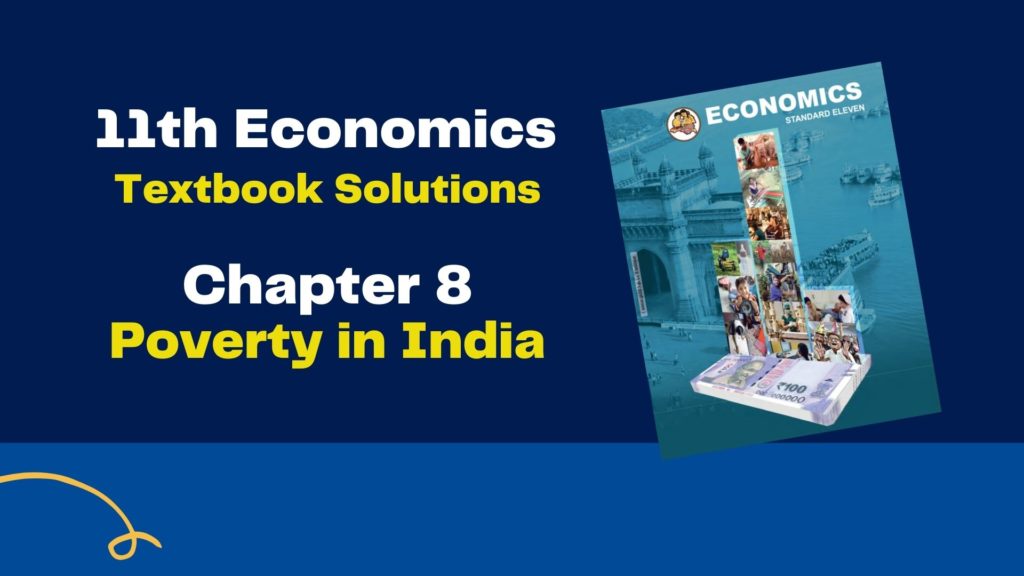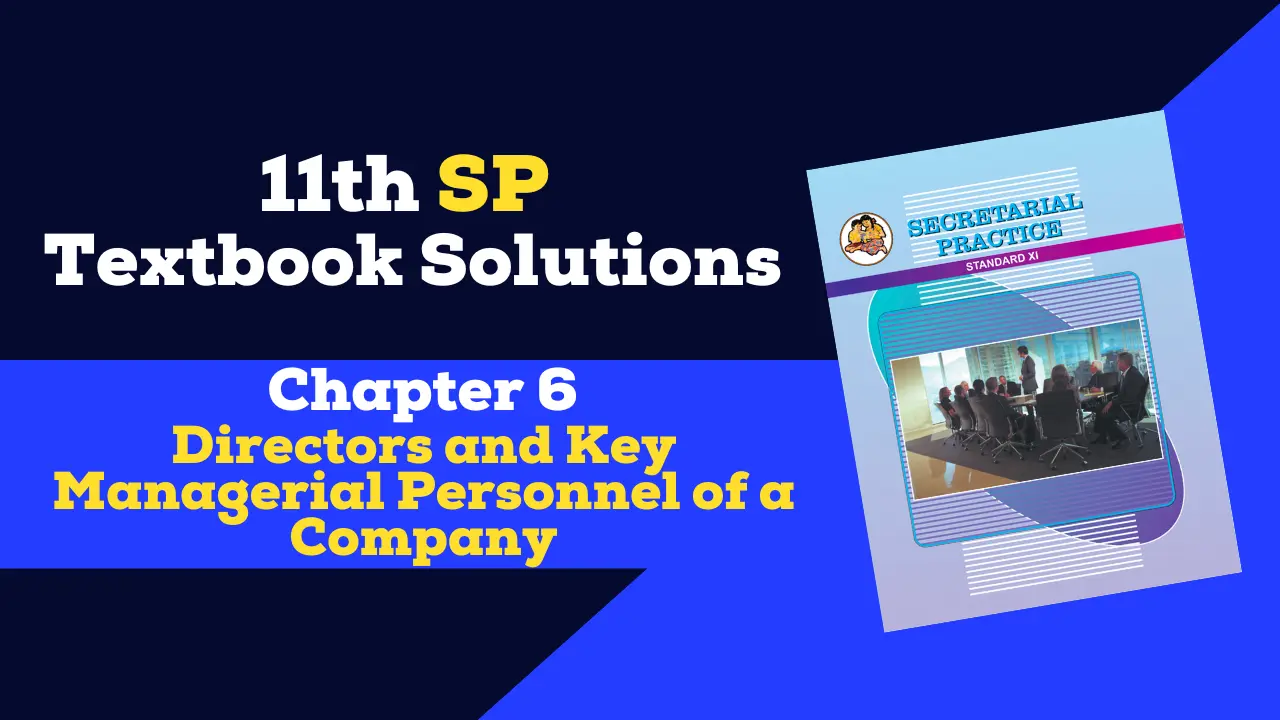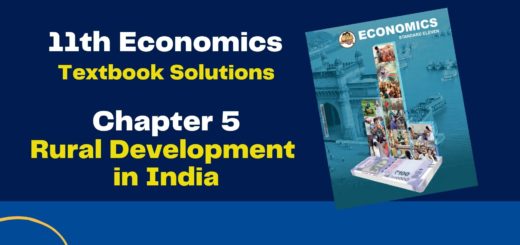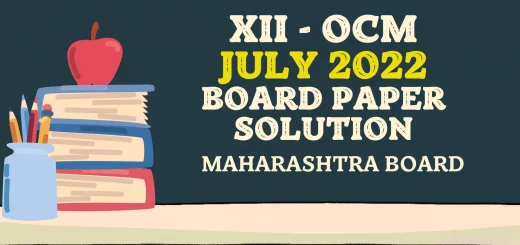11th Economics Chapter 8 Exercise Solution (Poverty in India) Maharashtra Board – Free Solution
Table of Contents
11th Economics Chapter 8 Exercise

Chapter 8 – Poverty in India
Q. 1. Assertion and Reasoning questions
1) Assertion (A) : Poverty level declines with a rise in agricultural output.
Reasoning (R) : Agricultural incomes have declined due to wide fluctuations in climatic conditions.
Options :
1) (A) is True, but (R) is False.
2) (A) is False, but (R) is True.
3) Both (A) and (R) are True and (R) is the correct explanation of (A).
4) Both (A) and (R) are True, but (R) is not the correct explanation of (A).
2) Assertion (A): Urban poverty is attributed mainly to spillover effects of migration among the rural poor.
Reasoning (R): Poor rural infrastructure, lack of alternative jobs results in forced migration.
Options :
1) (A) is True, but (R) is False.
2) (A) is False, but (R) is True.
3) Both (A) and (R) are True and (R) is the correct explanation of (A).
4) Both (A) and (R) are True, but (R) is not the correct explanation of (A).
3) Assertion (A): Relative poverty is found in all the countries of the world.
Reasoning (R): Differences in the levels of income is the only criteria for judging relative poverty.
Options :
1) (A) is True, but (R) is False.
2) (A) is False, but (R) is True.
3) Both (A) and (R) are True and (R) is the correct explanation of (A).
4) Both (A) and (R) are True, but (R) is not the correct explanation of (A).
4) Assertion (A): Poverty is not just lack of money but also lack of capabilities.
Reasoning (R): Lack of freedom to satisfy hunger, lack of health care facilities, denial of political freedom leads to poverty.
Options :
1) (A) is True, but (R) is False.
2) (A) is False, but (R) is True.
3) Both (A) and (R) are True and (R) is the correct explanation of (A).
4) Both (A) and (R) are True, but (R) is not the correct explanation of (A).
5) Assertion (A): Food security, credit facilities guarantee social protection to the poor.
Reasoning (R): Leakages in the administrative system perpetuates poverty.
Options :
1) (A) is True, but (R) is False
2) (A) is False, but (R) is True
3) Both (A) and (R) are True and (R) is the correct explanation of (A)
4) Both (A) and (R) are True, but (R) is not the correct explanation of (A)
Q. 2. Find the odd word out
1) Colours of Ration card – White, Green, Saffron, Yellow
2) High Poverty ratio – Chhatisgarh, Jharkhand, Bihar, Kerala
3) Calories – 2400, 1800, 2100, 2250
Q. 3. Give economic terms
1) Denial of opportunities to certain section of the people in the society. – Social exclusion
2) Concept of poverty that covers material and non-material dimensions. – Multi-dimensional poverty
3) Poverty judged on the basis of relative standards of living of the people. – Relative Poverty
4) Poverty that can be completely eradicated. – Absolute poverty
5) Threshold expenditure needed to satisfy basic human needs at socially acceptable levels. – Poverty line
Solution of other subjects
Solution of all Chapters of Economics
1 – 2– 3 – 4 – 5 – 6 – 7 – 8 – 9 – 10
Q. 4. Identify and explain the concepts from the given illustrations
1) Baban’s daughter had to be hospitalized due to weakness caused by undernourishment or lack of minimum calorie requirement in the intake of food.
Concept: Absolute poverty
Explanation: Absolute poverty is measured in terms of minimum calorie intake. Earlier, Planning Commission determined per capita daily calorie requirement of 2400 calories for a person living in the rural area and 2100 calories for a person living in the urban area.
2) Dhanajirao is a wealthy landlord, but his annual income is relatively less in comparison to entrepreneur Raobahadur.
Concept: Relative Poverty.
Explanation: Relative poverty is judged on the basis of comparison of relative standards of living of different sections of the people.
3) Urmi’s family live in a situation whereby they are not able to fulfil even the basic needs of life such as food, clothing and shelter.
Concept: Poverty
Explanation: Poverty refers to a situation in which a major section of the people in the society are unable to fulfil even the basic needs of life such as food, clothing and shelter due to lack of sufficient income.
4) Sanjay’s family receives food grains on the basis of yellow ration card through public distribution system.
Concept: Food security public distribution system
Explanation: To ensure food security, the Government of Maharashtra has introduced the Tri-Colour Family Ration Card.
5) In certain parts of the State, starvation-related deaths have been observed whereas in certain areas gross wastage of food has been reported.
Concept: Economic Inequalities
Explanation: Economic inequalities have been observed in the distribution of income, assets, consumption expenditure, credit facilities, agricultural landholdings etc.
Q.5. State with reasons whether you agree or disagree with the following statements
1) Population control is the only measure to eradicate poverty.
Answer: No, I disagree with this statement.
Reasons: a) There are many measures undertaken to eradicate poverty population control is one of them.
b) Agriculture: The Government announces Minimum Support Prices for selected crops to ensure stable agricultural income.
c) Rural Works: Employment opportunities are provided to the poor through the construction of rural roads, irrigation projects, rural electrification etc.
d) Rural industrialization: To promote employment in the rural areas, emphasis has been laid on setting up of small scale and cottage industries.
So, there are many measures to eradicate poverty.
2) Relative poverty is universal by nature.
Answer: Yes, I agree with this statement.
Reasons: a) Relative poverty is judged on the basis of comparison of relative standards of living of different sections of the people.
b) Relative poverty is measured with respect to differences in the levels of income, wealth, consumption, economic inactivity (unemployment, old age) etc.
c) Such poverty is found in all the countries of the world. It is an universal phenomenon.
d) Thus, relative poverty is universal by nature.
3) Regional imbalance is the only cause of poverty.
Answer: No, I disagree with this statement.
Reasons: a) There are many reasons that cause poverty.
b) Regional imbalance is also one of the causes of poverty.
c) Causes of poverty are Population explosion, Slow Economic Growth, Unemployment and Underemployment, Economic inequalities, Inflation etc
d) Thus, Regional imbalance is not the only cause of poverty.
Solution of other subjects
Solution of all Chapters of Economics
1 – 2– 3 – 4 – 5 – 6 – 7 – 8 – 9 – 10
Q.6. Answer in detail
1) Assess various measures undertaken to eradicate poverty.
Answer: Policy measures are undertaken for eradication of poverty are as follows.
1) Control of population
Family Welfare Programme and population policies have been introduced to keep a check over the population growth.
2) Agriculture
Farmers are provided with cheap credit facilities to purchase agricultural inputs. The Government also announces Minimum Support Prices for selected crops to ensure stable agricultural income.
3) Rural Works
Employment opportunities are provided to the poor through the construction of rural roads, irrigation projects, rural electrification etc.
4) Rural industrialization
To promote employment in the rural areas, emphasis has been laid on the setting up of small scale and cottage industries.
5) Minimum Wages
Minimum Wages Act was passed in 1948 to provide fair wages to agricultural and industrial workers. It has been revised from time to time.
6) Public Distribution System
To ensure food security, food grains are made available to the poor people at highly subsidized rates through ration shops under the public distribution system.
7) Nationalization of Banks
To ensure financial inclusion, credit facilities are made available to poor people at low rates of interest. For this purpose nationalization of banks was undertaken in 1969 and 1980.
8) Progressive Tax Measures
To reduce inequalities in the distribution of income, a progressive income tax system has been introduced.
9) Education
To increase the enrolment ratio, primary education has been made free and compulsory for all. Free education for girls, mid-day meal programmes, sanitation and safe drinking water etc. have also been provided.
10) Affordable Housing
Slum rehabilitation programmes and affordable housing facilities are provided to the rural and urban poor.
11) Health facilities
Primary health centres, government hospitals have been established to provide medical treatment at subsidized rates to poor people.
12) Skill development and self-employment
Skill development is considered one of the important aspects of job creation in India. For this purpose, opportunities need to be provided for skill-based training. This will inspire people towards entrepreneurship or self employment.
Solution of all Chapters of Economics
| Chapter Name | Solution Link |
| 1) Basic Concepts in Economics | Solution |
| 2) Money | Solution |
| 3) Partition Values | Solution |
| 4) The Economy of Maharashtra | Solution |
| 5) Rural Development in India | Solution |
| 6) Population in India | Solution |
| 7) Unemployment in India | Solution |
| 8) Poverty in India | Solution |
| 9) Economic Policy of India Since 1991 | Solution |
| 10) Economic Planning in India | Solution |
Check out other posts related to 11th Commerce
| Textbook Solutions of 11th Commerce (All Subjects) | Click Here |
| Free pdf of 11th Commerce Textbooks | Click Here |


